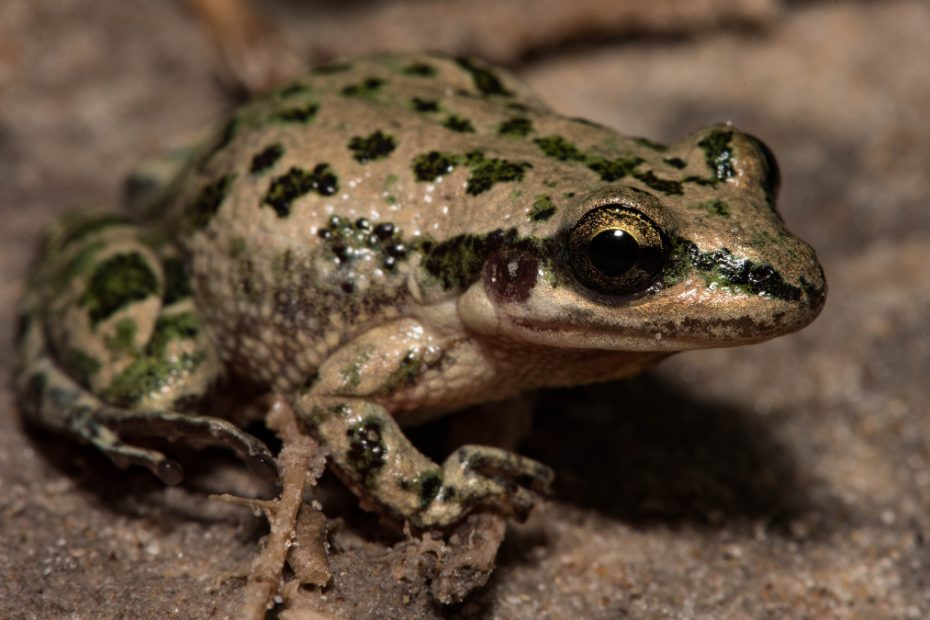Spotted Chorus Frogs are small amphibians found in wetland habitats in North America. They’re olive green or gray colored, with light green spotting on their back, as well as a white-colored underside. They’re about 3 to 4 cm maximally (1.25″) in size.
They are important to study and conserve because they are an essential part of many food chains. They also serve as indicators of the environmental ecosystem. However, they face threats from habitat loss, pollution, and disease. Supporting habitat conservation efforts and reducing the use of pesticides can help ensure their survival.
In this article, we will take a closer look at the physical characteristics, habitat preferences, behavior, and conservation status of this fascinating species.
Spotted Chorus Frog Taxonomy

The Spotted Chorus Frog, also known as Pseudacris clarkia in the family of Hylidae, can be classified into the following taxonomy:
| Common Name | Spotted chorus frog |
| Scientific Name | Pseudacris clarkia |
| Kingdom | Animalia |
| Phylum | Chordata |
| Class | Amphibia |
| Family | Hylidae |
| Subfamily | Acrisinae |
| Genus | Pseudacris |
| Species | P. clarki |
Spotted Chorus Frog Physical Characteristics
The Spotted chorus frog’s physical characteristics make them easy to spot in the wild. Their physical characteristics are as follows.
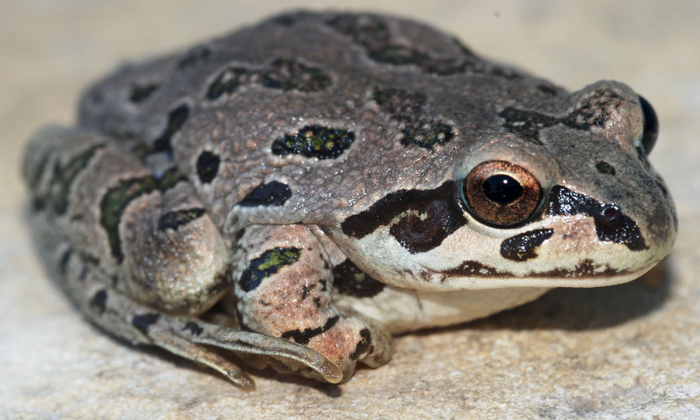
Size
They are small amphibians with broad heads and pointed snouts. They measure 3 to 4 cm in length (1.25″) and weigh 1 to 3 grams.
Coloration and Markings
Spotted Chorus Frogs have a grayish-brown to greenish-gray background. They also have a ladder pattern of dark spots that vary in size and density. This coloration and markings provide excellent camouflage that helps in their survival.
Skin Texture
The Spotted Chorus Frog has smooth, moist skin with small bumps and lacks warts and toxin-secreting glands. Their skin secretes a mucus-like substance to stay moist and protected.
Species of Spotted Chorus Frogs Found In North America
There are 18 species found in North America, each with its unique characteristics. Aside from the physical characteristics, geographic location can also help in their identification. 4 of the most common species are as follows.
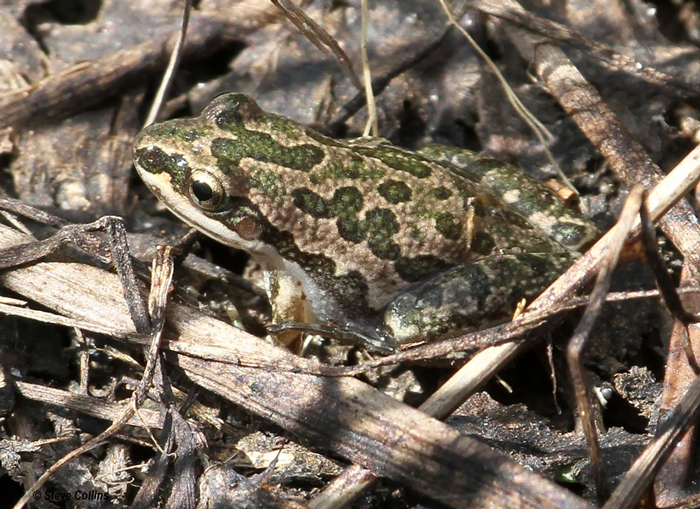
- Northern Spotted Chorus Frog (Pseudacris maculata): It is found in the eastern United States and Canada. It’s known for its distinctive call, a high-pitched trill that can last for several seconds.
- Southern Spotted Chorus Frog (Pseudacris nigrita): This frog is seen in the southeastern United States. This Frog’s call is a rapid series of high-pitched notes, similar to the sound of a cricket
- Strecker’s Chorus Frog (Pseudacris streckeri): Strecker’s Chorus Frog is found in the central United States, primarily in Texas and Oklahoma. This frog’s call is a rapid series of short notes.
- Little Grass Frog (Pseudacris ocularis): This frog is found in the southeastern United States, from Texas to Virginia. Its call is a series of short, high-pitched notes, similar to the sound of a sewing machine.
Adaptation Features of Spotted Chorus Frogs
They survive in wetlands through their metamorphosis from tadpole to adult. The tadpoles change, allowing them to move from aquatic to terrestrial environments.
They developed multiple physical adaptations, such as thin and permeable skin, webbed feet, and adhesive toe pads. All these enable Spotted Chorus Frogs to swim efficiently, climb surfaces and absorb oxygen and moisture.
Behavioral adaptations, such as hiding from predators and communicating with calls, allow them to establish territories and survive in their wetland habitats.
Spotted Chorus Frogs Habitats And Behaviors
Spotted Chorus Frogs are widely distributed from the eastern US to central Mexico. They can be found in various wetland ecosystems adjacent to grasslands and forests, with vegetation cover. They prefer areas with ample water sources and shallow water with emergent vegetation for breeding.
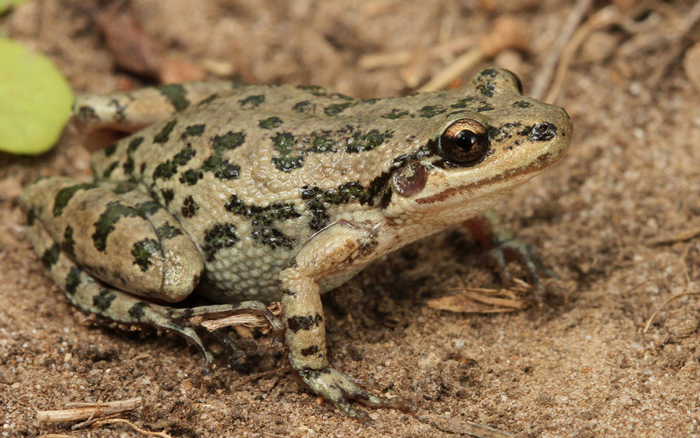
These Frogs can be found at lower elevations, often below 2,000 feet, but have been found at elevations up to 9,000 feet in some parts of their range.
With distinctive geographical and environmental habitats, they have distinctive behavior as follows.
Activity patterns
The Chorus Frogs are primarily nocturnal and active during rainy nights to find food and mates. They take shelter during the day to avoid predators and maintain moisture levels. However, studies have also shown that they can be active during the day in cooler temperatures and under cloud cover.
Locomotion
The Spotted Chorus Frog, with long legs and adhesive pads on their toes, can jump up to three times their body length. This makes them agile and quick in evading predators and catching prey. Their jumping ability is impressive, but they can also walk and run on their hind legs for short distances.
Social structure
The Spotted Chorus Frog is a solitary creature, except during the breeding season. During this time, males will gather in choruses and call out to females. These choruses can contain up to 100 males. After mating, the females will lay their eggs in shallow pools or other bodies of water.
Communication
The Spotted Chorus Frog utilizes a distinct call to communicate for mating and territorial purposes. Its call consists of short, repetitive notes resembling a finger running over a comb’s teeth. However, its call can be mistaken for the Mountain Chorus Frog’s call, which is closely related.
Predators and defense mechanisms
The Spotted Chorus Frog has many predators, including snakes, birds, and small mammals. Their defense mechanisms include camouflage and toxin secretion. The Frog has brown or green mottled skin, which allows it to blend into its surroundings. If threatened, the frog can also secrete toxins from its skin, which can cause illness or death in some predators. However, while this Frogs do produce toxins, the level of toxicity varies among individuals and populations.
Spotted Chorus Frog behavior helps them survive and thrive in their environments. From their solitary lifestyles to their vocalizations and defense mechanisms. Let us discuss some of their behaviors
In terms of activity patterns, these unique Frogs are primarily nocturnal, meaning they are most active at night. However, they can also be active during the day and at dawn and dusk (crepuscular).
They are well adapted to life in the water, using swimming as their primary mode of transportation. They are also capable of hopping short distances on land and even climbing vegetation when necessary.
Socially, these frogs are generally solitary creatures but will only interact with the females during mating periods.
In addition, they use several methods to communicate with each other. These include vocalizations, body language, and chemical signals. The males’ distinctive calls can be heard up to a mile away and are used to attract females and deter other males.
Furthermore, they have several predators, including snakes, birds, and small mammals. To avoid these threats, they rely on camouflage and quick movements to escape. They are also able to secrete toxins through their skin, which can be harmful to some predators.
Mating Habits And Breeding Behaviors of Spotted Chorus Frogs
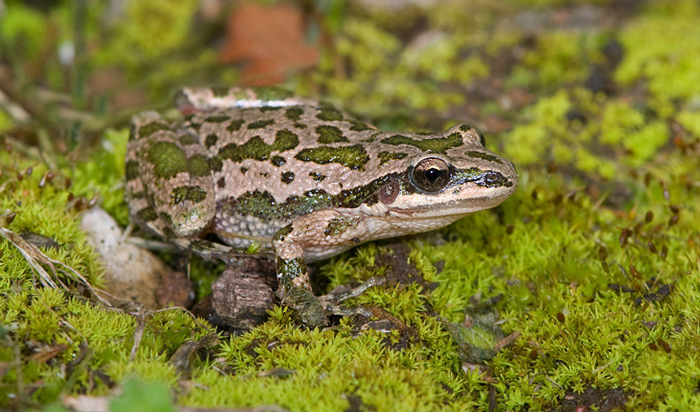
Like every other animal these frogs have some mating and breeding habits they exhibit. Below are some of these habits.
Mating season
Spotted Chorus Frogs typically breed from January to June in the southeastern United States. However, in other parts of their range, breeding may occur at different times of the year, depending on local conditions.
Mating Rituals
During the breeding season, males congregate in and around bodies of water and call out to attract females. Their calls are distinctive and can be heard from up to a mile away. Females choose mates based on the quality of their calls and may lay their eggs in the same area as other females.
Fertilization Type
They engage in external fertilization, meaning that the female lays her eggs, and the male fertilizes them outside of her body.
Egg-laying habits
They lay their eggs in clusters attached to emergent vegetation, such as lily pads and reeds, in shallow water. Females can lay up to several hundred eggs at a time.
Development Stages
The eggs hatch into tadpoles, which feed on algae and other aquatic vegetation. After several weeks, the tadpoles undergo metamorphosis and become adult frogs. This process can take up to three months.
Parental Care
They do not exhibit parental care for their young. Once the eggs are laid, the adults do not provide any further care for their offspring.
Spotted Chorus Frogs Diets
The spotted Chorus Frog diet consists primarily of insects and other small invertebrates. While insects make up the bulk of their diet, they have also been known to eat small spiders, snails, and even other frogs.
They have been observed taking advantage of seasonal food sources, such as caterpillar outbreaks, and can also scavenge on carrion.

They are also opportunistic feeders, meaning they will eat whatever is available to them in their environment. In a study conducted in Texas, these Frogs were found to switch from eating mainly insects to eating more snails and slugs. This took place during a dry period when insect populations were low.
However, observation shows they use a variety of foraging strategies to capture their prey. These strategies are-
Sit-and-wait
This involves remaining motionless in a concealed location. This can be under vegetation or in the water, and waiting for prey to come within striking distance.
Once the prey is close enough, the frog will quickly extend its sticky tongue to capture it.
Active Hunting
This involves the use of quick movements to chase down their prey. They are particularly skilled at catching flying insects, such as moths and beetles. They do this by leaping into the air and snatching them with their tongues.
Spotted Chorus Frogs Conservation Status
The conservation status of this species varies depending on the specific population and environment. But overall, they are considered to be a species of least concern by the International Union for Conservation of Nature (IUCN).
However, these frogs face several threats, including habitat loss and fragmentation. Human Activities such as urban development, agriculture, and logging can destroy or alter frog habitats. This will make it unsuitable for the frogs to live and reproduce.

Pollution from pesticides, fertilizers, and other chemicals can contaminate their water sources, harming the frogs and their prey.
Climate change can alter the timing of breeding and migration, which can disrupt their life cycles. Non-native species, such as predatory fish and bullfrogs, can compete with Spotted Chorus Frogs for resources and prey on them.
Conservation Efforts To Protect Spotted Chorus Frogs
To protect their populations, several conservation efforts are underway, which include;
- Habitat Preservation Programs
Legal protections have been established in some areas to prevent the destruction of wetlands and other important habitats by human activities. The United States Clean Water Act is a major law that regulates the discharge of pollutants into waterways, including wetlands.
These programs are made available by conservative organizations for the conservation of Spotted Chorus Frogs. Also, legal protections help to preserve and protect their habitats.
- Captive Breeding Programs
Captive breeding programs have been successful in preserving amphibian species, like the California Red-legged Frog. Calgary Zoo has a captive breeding program for Spotted Chorus Frogs in Canada to increase their numbers for reintroduction into the wild.

- Habitat Restoration
Restoration projects aim to improve and restore degraded wetland habitats to make them more suitable for frogs. Invasive plant species are removed, and native plant communities are re-established to create a natural habitat.
Water quality is improved, and water bodies are restored to support the growth of native plant species. Such efforts play a crucial role in preserving these species.
Research institutions are investigating the effects of climate change, disease, and pollution on chorus Frogs to develop mitigation strategies. They’re studying changes in temperature and precipitation patterns that affect frog habitats and breeding cycles.
Chytrid fungus, a major threat to amphibians globally, has been detected in some Spotted Chorus Frog populations. Scientists are investigating its impact and ways to prevent its spread.
Importance Of Continued Conservation Efforts of Spotted Chorus Frogs
- Continued frog conservation efforts are crucial for their survival and the wetland ecosystems they inhabit.
- These frogs are important as both predators and prey in the ecosystems which human activities threaten.
- Wetlands provide essential habitat and ecosystem services like water purification and carbon sequestration.
- Protecting these frogs and their ecosystems can preserve biodiversity and ensure continued services.
- Developing effective conservation strategies for this species can provide insights into protecting other amphibians.
Interesting Facts About Spotted Chorus Frogs
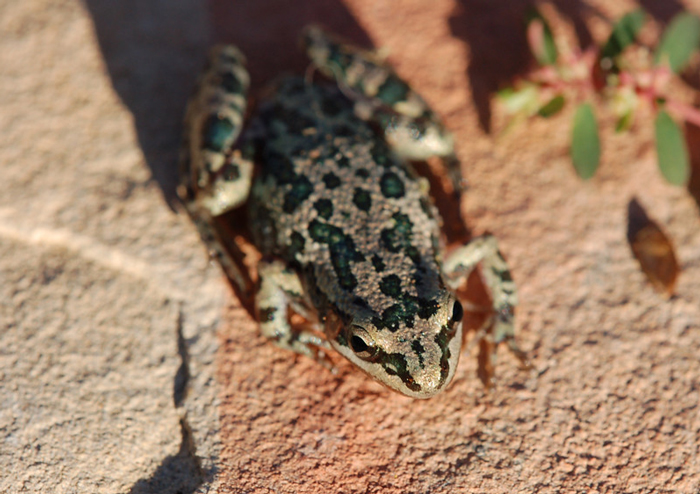
- They are small, nocturnal frogs that typically grow to be around 1.25 inches (3 to 4 cm) long.
- Listed as a species of special concern in Georgia and is declining in many parts of its range due to habitat loss and fragmentation.
- Male frogs use unique “chuckling” or “snore-like” vocalizations to attract mates during the breeding season, audible up to 100m.
- These Frogs are essential in the food chain as they serve as prey and predators, regulating the population of small insects.
- They are able to tolerate freezing temperatures by producing a natural antifreeze called glucose
- Spotted Chorus Frogs are often used as a bioindicator species to assess the health of wetlands and other aquatic habitats.
Conclusion
Spotted Chorus Frogs are nocturnal amphibians known for their unique vocalizations used during the breeding season to attract mates. They play an essential role in the food chain through predator-prey interactions, serving as prey for various predators. Also, they help regulate the population of small insects and invertebrates they feed on.
While not currently endangered, these frogs face threats from habitat loss, pollution, and climate change. It is important to continue research on frog ecology and conservation efforts to sustain the ecosystems they inhabit. For further reading and learning about biodiversity conservation, readers can explore additional resources.

Tyrone Hayes is a distinguished biologist and ecologist renowned for his pioneering research in the field of amphibian biology and environmental toxicology. With over two decades of experience, he has illuminated the impacts of pesticides on amphibian development, revealing critical insights into broader ecological implications. Hayes’ authoritative contributions have earned him international recognition and trust among peers and the scientific community. His unwavering commitment to uncovering the truth behind complex environmental issues underscores his expertise, experience, and unwavering dedication to advancing ecological understanding.
